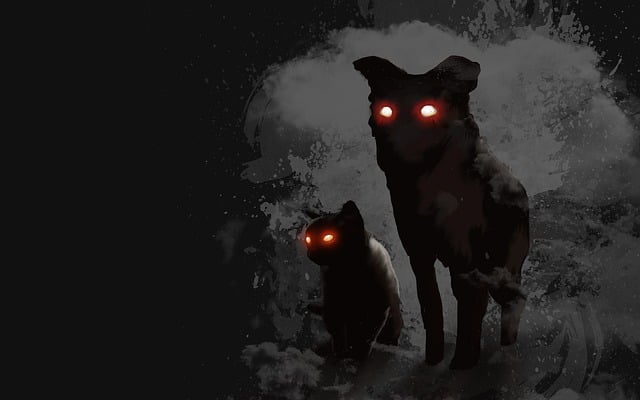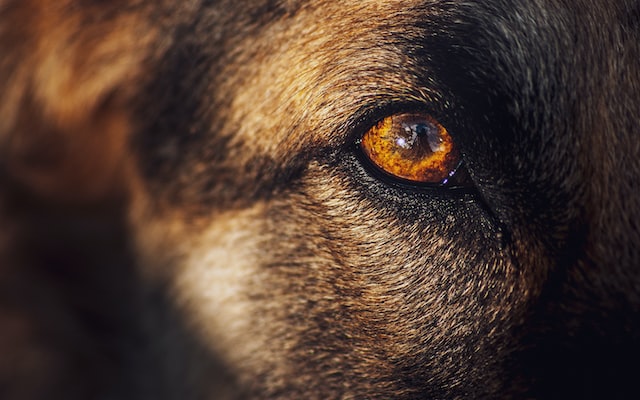Dogs’ eyesight is amazing! But even more amazing are the dog eye colors. From amber to green, you can find a whole range of eye colors in dogs. If you want to understand what a specific dog’s eye color says about its genetics, check out our dog eye color chart to see which colors are most common in which breeds. Now let us ask you a question. Do you ever wonder why your dog never gets “red eyes” when you capture his photographs at night?
One of the most common questions that dog owners ask is, “Why do dog eyes glow?” Well, it’s all thanks to the reflective layer of the dogs’ eyes, which helps them see better in low-light conditions. You’ll learn more about this amazing adaptation in the next section of this article. But did you know that different dog breeds have different eye reflection colors? Check out our dog eye reflection color chart to see the colors that different dogs’ eyes can reflect.
Why do Dog Eyes Glow?
All dogs’ eyes have a reflection in the color of their iris. This reflection can be seen in the dark as well as in some light, especially when taking photographs. Most dogs dilate their pupils in the dark. This makes the reflection in their eyes appear even brighter. This phenomenon is called “eye shine.” But why do dog eyes glow in the dark?
The answer lies in a layer of tissue in their eyes called the tapetum lucidum. Yes! A dog’s eyes, unlike a human’s, have this reflective layer of cells at the back of the eye. This mirror-like layer is present before the blood-filled eye layer called the choroid. And this is the reason why most dogs don’t have “red eyes” in the photographs. Their red choroid layer is masked by another layer that reflects different colors, varying from green and blue to orange or yellow in different dogs.
Tapetum lucidum helps dogs see better in dark conditions. It is what allows the dog’s light-sensitive cells of the retina to function much more efficiently. Since it is reflective, it reflects the incident light back onto the retina again to enhance vision in the dark. In addition to the tapetum lucidum, dogs also have a layer of cells called the “double rod layer.” This layer is composed of rod cells, which are twice as numerous as those in the human eye, which allows the dog to register far more light than us, even in the dark. This is how a dog can see better than humans in the middle of the night.
Do All Dogs’ Eyes Glow?

No! Not all dogs necessarily have glowing eyes. Although all dogs have eyes that reflect light (so as to create vision), not all dogs have “reflective” eyes. Reflective or glowy eyes are those that have a layer of reflective tissue (tapetum) between the retina and the optic nerve. This tissue is itself colored and helps to reflect light back into the eye, making it easier for the dog to see in low light conditions.
The color of the tapetum can differ from breed to breed. However, not all dog breeds have this tissue, so not all dogs have reflective eyes. In fact, 1.9% of dogs, particularly those with blue eyes, have no tapetal area at all. Because the tapetum isn’t present to produce the colorful reflection, the red blood vessels in the choroid tissue at the back of the eye are visible when a photograph is taken. This produces the “red eye” appearance.
Dog Eye Reflection Color Chart

The pigment present in the cells of the tapetum lucidum contains zinc and/or riboflavin (an amino acid), both of which operate as reflectors for the tissue. The color of reflection can vary between species and even within a single species, depending on how tightly packed the tapetum cells are with zinc or riboflavin. While some dogs contain more zinc, others may have more riboflavin. Some dogs may have a healthier balance of both components. Similarly, the reflection color is also determined by the dog’s eye color to a great extent.
This dog eye reflection color chart will help you learn some reflection colors that are common to popular dog breeds.
Dog Breed |
Eye Reflection Color |
| Siberian Husky |
Red reflection |
|
English Springer Spaniel |
Orange reflection |
| Weimaraners | Red reflection |
| Yellow Labrador | Soft yellow reflection |
| Black Labrador | Deep yellow or green reflection |
| Schnauzer | Blue or turquoise reflection |
| Australian Shepherd | Red reflection |
| Maltese |
Red reflection |
Is a Dog Eye Reflection Color Chart Applicable to Puppies?
The above dog eye reflection color chart may not be applicable to young puppies, as an adult dog’s eyes are different from when he’s a puppy. Puppies’ eyes go through several changes as they mature, one of which is the development of pigmentation. Therefore, it obviously makes sense that young dogs have different eye reflection colors than adult dogs.
The transition, as well as the change in eye color, often takes place gradually. The color of a young dog’s eye is usually a brighter, more intense version of the color of an adult dog’s eye. This is because the pup’s eyes are still developing and haven’t yet reached their full pigmentation. Sometimes, there may be no pigment at all, so the puppy will reflect a red reflection similar to that of blue-eyed dogs. The process of pigment development is finished by the third month at the latest. Adult dogs typically have a darker, more muted eye reflection color.
Final Thoughts on Dog Eye Reflection Color Chart
The glowy eyes are a peculiar feature of dogs that enable them to have enhanced night vision. The reflection or glow is produced by the tapetum tissue present on the back of the eye and may vary from dog to dog. The reflection by tapetal cells is the actual source of that spooky glow, which is entirely natural and is nothing to be worried about.
We hope our dog eye color reflection chart has helped you learn more about this intriguing biological concept. Now you can look at those spooky eyes of your dog in the dark and use our chart to determine what shade of reflection they might be emitting! But if you detect any changes in the eye reflection color of your dog (i.e., if it is becoming brighter or duller), it is advised that you consult your veterinarian. Unless it is a puppy, this changing reflection color might be a sign of an eye condition that needs to be treated.





